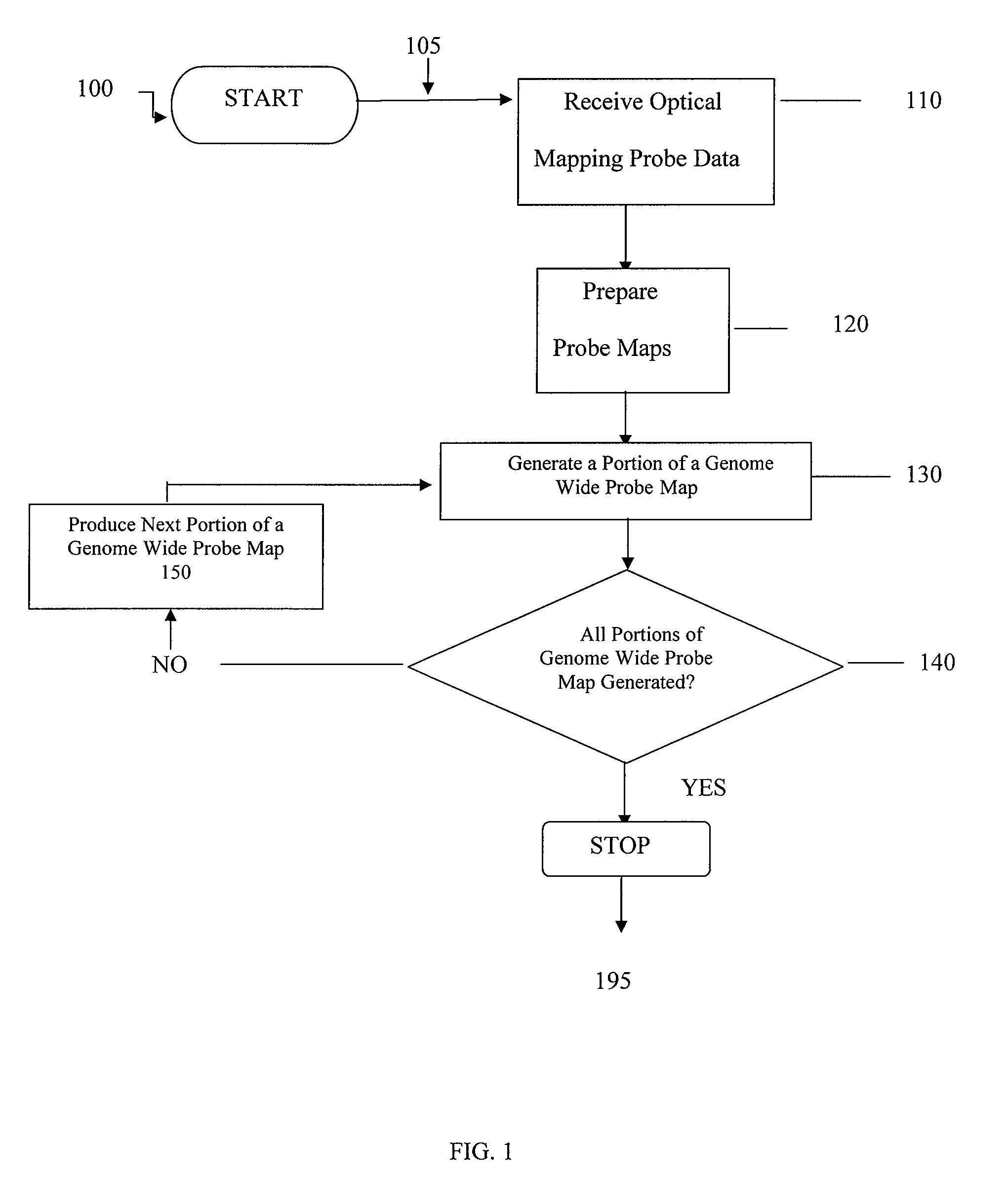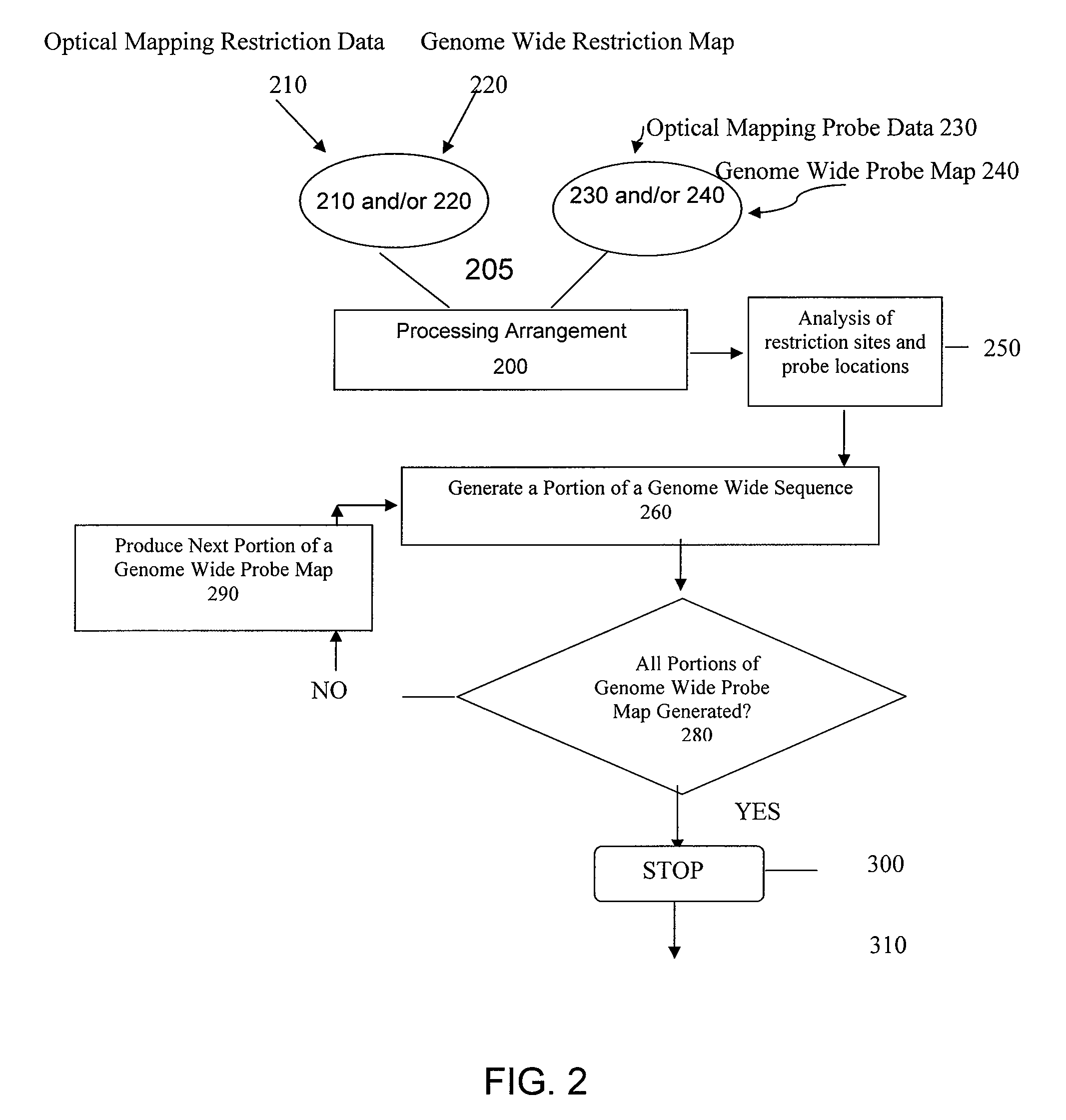Methods, computer-accessible medium, and systems for generating a genome wide haplotype sequence
a technology of computer-accessible medium, which is applied in the direction of instruments, analogue processes for specific applications, electric/magnetic computing, etc., can solve the problem that methods have not been used to generate genome wide haplotype sequences
- Summary
- Abstract
- Description
- Claims
- Application Information
AI Technical Summary
Benefits of technology
Problems solved by technology
Method used
Image
Examples
example 1
Conventional Optical Mapping Technology to Generate Restriction Maps
[0079]Uncloned DNA (e.g., DNA directly extracted from cells by lysing) can be randomly sheared into 0.1-2 Mb pieces and attached to a charged glass substrate, where it is reacted with a restriction enzyme, then stained with a fluorescent dye. Such a technique is described, e.g., in J. Jing et al., “Automated High Resolution Optical Mapping Using Arrayed, Fluid Fixated, DNA Molecules,” Proc. Natl. Acad. Sci. USA, 95:8046-8051, 1998. The restriction enzyme cleavage sites appear as breakages in the DNA under fluorescent microscope.
[0080]Tiled images of the surface may be collected automatically using a fluorescent microscope with a computer controlled x-y-z sample translation stage. The images can be analyzed by computer procedures to detect bright DNA molecules and locate breakages, which correspond to restriction enzyme cleavage sites. The approximate size of the distances between restriction sites is estimated based...
example 2
Exemplary Procedures to Generate Genome Wide Probe Maps and / or Haplotype Sequences
[0082]Exemplary techniques can be used to combine multiple probe maps and / or portions of genome wide probe maps (e.g, indicating the location of small 6 bp LNA probes) to generate a genome wide probe map and / or genome wide haplotype sequence. For example, probe maps can be aligned with each other, thus effectively producing one genome wide probe map that may show most or all locations where the oligonucleotide probes hybridized.
[0083]Such exemplary probe maps can be created on a scaffold of restriction maps by using a restriction enzyme sites located and determined is present in all maps (e.g., all probe maps and all restriction maps). Each probe map may be independently aligned with at least one genome wide restriction map created using the same restriction enzyme. Corresponding locations in other haplotype may be checked for any match, since the two haplotypes for most mammalian genomes may be very s...
example 3
Combination of Statistical Models of Chemical Processes with Resilient Procedures
[0106]Table 1 and Table 2 below show exemplary results of running the heuristic sequence assembly procedure on simulated data derived from random sequences (Table 1) and human chromosome 1 (Table 2). Both tables show the sequence error rate per 10,000 bases. Thus an error rate of 1 would correspond to an accuracy of 99.99%. Tables 1 and 2 show the error rate for difference size probes, some of which include universal bases. The location of universal and regular bases is shows as a pattern using the character x for each regular base and a dash (-) for each universal base. To generate the simulated data, a random DNA sequence was used and computed the probe map of a single restriction fragment of size 1 kb, for all possible probes for the probe type chosen was computed. For example, for a probe with 6 specific bases and 4 universal bases and the pattern xx-x--x-xx for the specific bases, there are a total...
PUM
| Property | Measurement | Unit |
|---|---|---|
| melting temperature | aaaaa | aaaaa |
| melting temperature | aaaaa | aaaaa |
| melting point | aaaaa | aaaaa |
Abstract
Description
Claims
Application Information
 Login to View More
Login to View More - R&D
- Intellectual Property
- Life Sciences
- Materials
- Tech Scout
- Unparalleled Data Quality
- Higher Quality Content
- 60% Fewer Hallucinations
Browse by: Latest US Patents, China's latest patents, Technical Efficacy Thesaurus, Application Domain, Technology Topic, Popular Technical Reports.
© 2025 PatSnap. All rights reserved.Legal|Privacy policy|Modern Slavery Act Transparency Statement|Sitemap|About US| Contact US: help@patsnap.com


